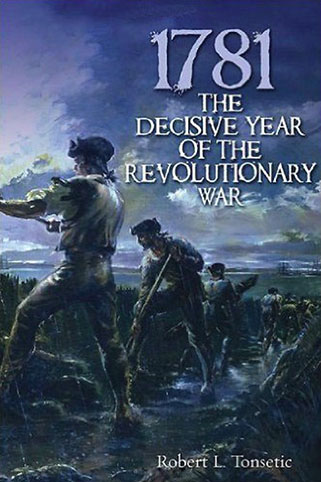Description
 1781: The Decisive Year of the Revolution
1781: The Decisive Year of the Revolution
By Robert L. Tonsetic. The Treaty of Paris in 1783 formally ended the American Revolutionary War, but it was the pivotal campaigns and battles of 1781 that decided the final outcome. 1781 was one of those rare years in American history when the future of the nation hung by a thread, and only the fortitude, determination and sacrifice of its leaders and citizenry ensured its survival.
By 1781, America had been at war with the world’s strongest empire for six years with no end in sight. British troops occupied key coastal cities, from New York to Savannah, and the Royal Navy prowled the waters off the American coast.
The remaining patriot forces were hunkered down in the hinterland, giving battle only at opportunities when British columns ventured near. But after several harsh winters, and the failure of the nascent government to adequately supply the troops, the American Army was fast approaching the breaking point.
The number of Continental soldiers had shrunk to less than 10,000, and the three-year enlistments of many of those remaining were about to expire. Mutinies began to emerge in the ranks, and it was only the arrival of French troops that provided a ray of hope.
In a shift of strategy, the British began to prioritize the south. After shattering the American Army under Horatio Gates at Camden, South Carolina, the British army under Lord Cornwallis appeared unstoppable, and was poised to regain the strategically important Carolinas, Georgia and Virginia for the Crown.
However, when Gen. Nathaniel Greene arrived to take command of patriot forces in the South, the crafty general was able to turn the tables.
By dividing his own army, he forced the British to divide theirs, dissipating their juggernaut and forcing Cornwallis to confront a veritable hydra of resistance.
1781 was a year of battles. Dan Morgan defeated the notorious Banastre Tarleton at Cowpens. Then Greene suffered defeat at Guilford Courthouse, only to rally his forces and continue to fight on, assisted by Swamp Fox Francis Marion and Light Horse Harry Lee. While luring Cornwallis north, Greene was able to gather new strength and launch a counterattack, until it was Cornwallis who felt compelled to seek succor in Virginia.
He marched his main army to Yorktown on the peninsula, upon which the American and French armies and the French fleet all converged. On Oct. 19, 1781, Cornwallis surrendered his weary and bloodied army.
In this book, renowned historian Robert L. Tonsetic provides a detailed analysis of the key battles and campaigns of 1781, supported by numerous eyewitness accounts from privates to generals in the American, French and British armies.
He also describes the diplomatic efforts under way in Europe during 1781, as well as the Continental Congress’s actions to resolve the immense financial, supply and personnel problems involved in maintaining an effective fighting force in the field. With its focus on the climactic year of the war—1781—this book is a valuable addition to the literature on the American Revolution, providing readers with a clearer understanding of how America—just barely—retrieved its independence from the abyss.
Softcover, 288 pages

